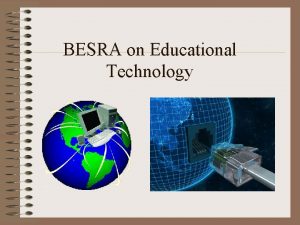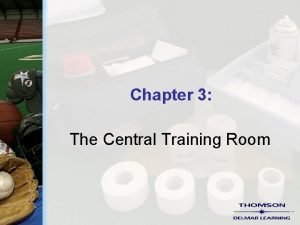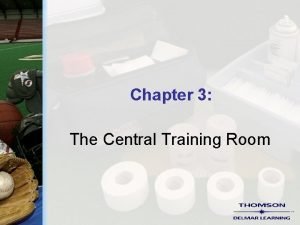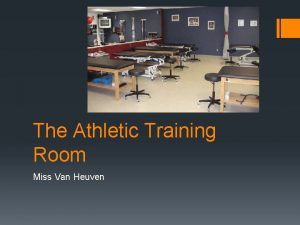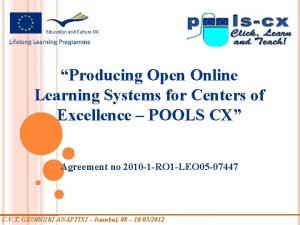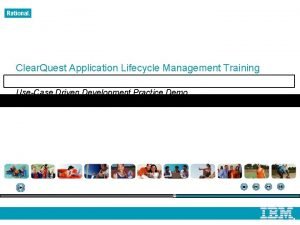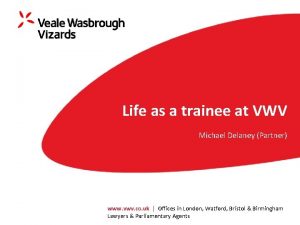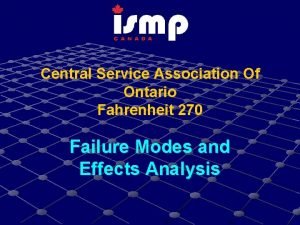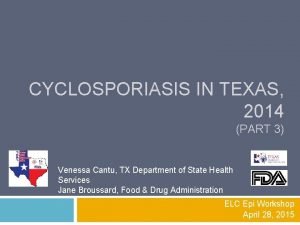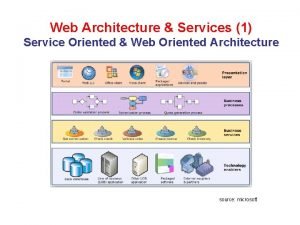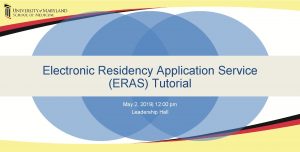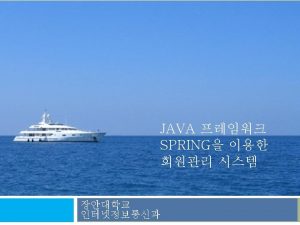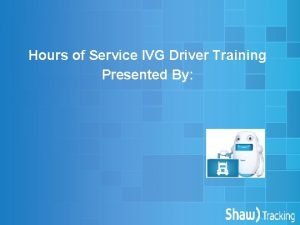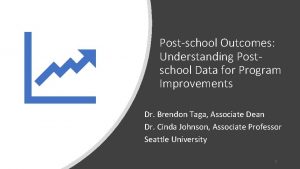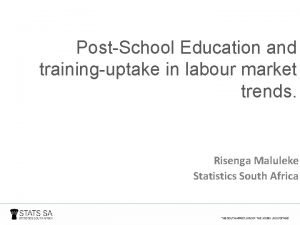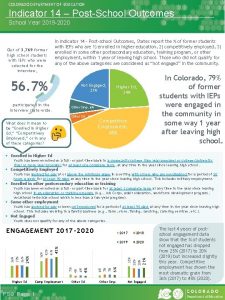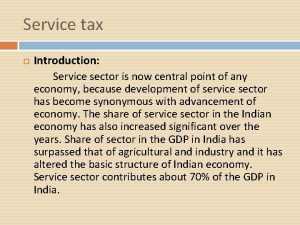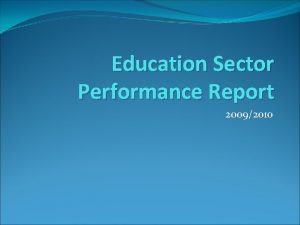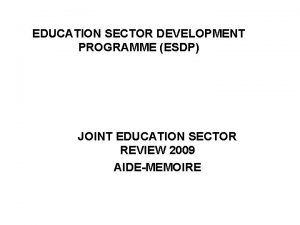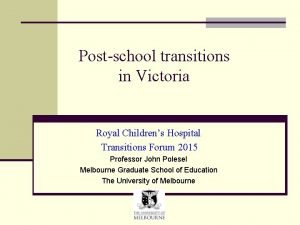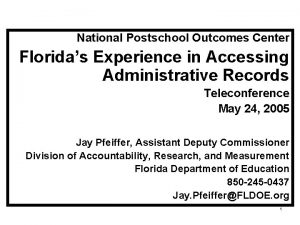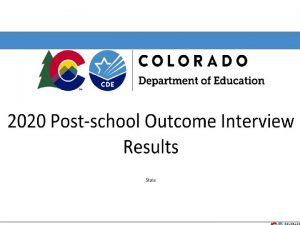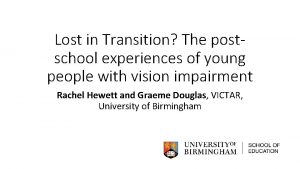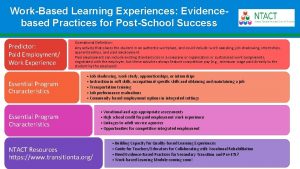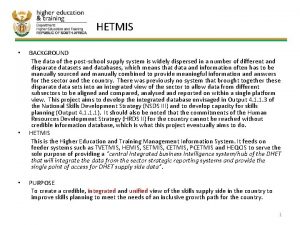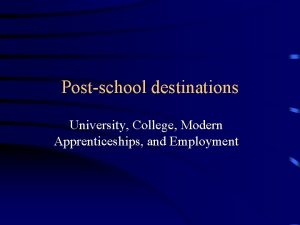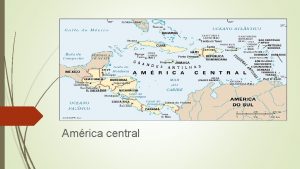Central Application Service for PostSchool Education Training Sector




























































































- Slides: 92

Central Application Service for Post-School Education & Training Sector Regional Communication Visit

WELCOME & APOLOGIES 2020 -11 -26 2

Agenda 1. 2. 3. Opening Welcome & Apologies Confirm Meeting Objectives Review of Consolidated CAS Enterprise Architecture 1. Detailed review of CAS Enterprise Architecture deliverable 1. 2. 3. 4. 5. 6. 7. 8. 9. Chapter 1 – Overview Chapter 2 – Service Model Chapter 3 – Governance Chapter 4 – Standard Operating Procedures Chapter 5 – ICT Architecture Chapter 6 – Human Resource Management Chapter 7 – Advocacy & Communication Chapter 8 – Stakeholder Engagement Chapter 9 – Monitoring & Evaluation 2. Legislative Process for enacting CAS 3. Review of CAS Implementation Plan and Financial Model 1. Chapter 10 – Implementation Plan 2. Chapter 11 – Financial Model 3. Key Recommendations 4. 5. Lunch Discussion Sessions 6. Way Forward 75 min 15 min 30 min 45 min 105 min 1. Standardisation Process 2. Application Form and Statuses 2020 -11 -26 15 min 120 min 15 min 3

CONFIRM OBJECTIVES 2020 -11 -26 4

Confirm Objectives • • • Provide an Overview of the CAS Enterprise Architecture Enable questions by participants Enable raising of comments and issues by participants Address comments, questions and issues where possible Gather Input on key topics Agree Way Forward and obtain nominations to user groups To cover the Agenda we have to implement strict time-keeping on reviewing the detail of the Enterprise Architecture deliverables 2020 -11 -26 5

REVIEW OF CONSOLIDATED CAS ENTERPRISE ARCHITECTURE 2020 -11 -26 6

Overview of Enterprise Architecture project 2. Service Model 1. Project Management & QA 3. Gover nance 4. SOPs 5. ICT 6. HRM Enterprise Architecture Review 7. Advocacy 8. Stakeholder Management 2020 -11 -26 9. Monitoring & Evaluation 7 11. Cost Estimates 12. Consolidated Enterprise Architecture 1. PMO 10. Implementation Plan Enterprise Architecture translates the concept or vision for a future business or organisation into a design document that defines how the business should operate, be structured and supported with technology and processes

The CAS Concept Applicants Central Application Service PSET Institutions Apply Facilitate Admit Online Applications Offline Applications CAS Process Walk-in applications Investigate opportunities Prepare application Submit application Change application Provide additional information Consider and accept offers Prepare application cycles Capture off-line applications Check applications Submit application Communicate with applicants Resolve applicant queries Refer regretted applicants 2020 -11 -26 8 Prepare programme data Receive applications Request additional information Update application status Select and make offers Register and admit students

Consolidated CAS Enterprise Architecture chapters Vol 4 9 Vol 3 2020 -11 -26 Vol 2 Chapter 0 – Executive Summary (including Recommendations) Chapter 1 – Overview of Consolidated CAS Enterprise Architecture Chapter 2 – Service Model Chapter 3 – Governance & Management Report Chapter 4 – Standard Operating Procedures Chapter 5 – ICT Architecture & Infrastructure Chapter 6 – Human Resource Management Chapter 7 – Advocacy & Communication Strategy Chapter 8 – Stakeholder Engagement Strategy Chapter 9 – Monitoring & Evaluation Framework & Policy Chapter 10 – Implementation Plan Chapter 11 – Financial Model Vol 1 • • •

Input to CAS Enterprise Architecture Direct Engagements Represented at CAS Governance Forums Higher Education South Africa (HESA) Department of Basic Education (DBE) Universities - Registrar WITS DHET - TVET Colleges Universities - Registrar UJ DHET - SETAs Universities – Registrar Unisa National Career Advice Portal (NCAP) DHET - Community Colleges National Skills Fund (NSF) DHET – VCET Branch South African College Principals' Organisation SETA CEO Forum Study Tour - UCAS Study Tour – Ireland CAO KZN CAO National Student Financial Aid Scheme (NSFAS) Department of Labour (Do. L) Public Services Commission Pw. C Higher Education Conference ITS User Group 2020 -11 -26 10

CAS Enterprise Architecture validation July 2015 Registrar Forum Service Working Group Technical Working Group Advisory Committee Steering Committee 28 July 7 July 9 July 16 July 30 July Nov 2015 March 2016 4 November 2 March 3 March 10 March 6 April The CAS Enterprise Architecture was submitted to the Minister in March 2016 and was approved by the Minister on 31 March 2016 The CAS Enterprise Architecture has been published on the DHET website at http: //www. dhet. gov. za/Site. Pages/Org. Universities. aspx 2020 -11 -26 11

Levels of Engagement Time to Launch Universities TVET Colleges Community Colleges SETA’s 2 -4 yrs 5 yrs 6 yrs Level of Engagement to Date • Review of application forms • Engagements at Registrar levels and selected Admissions offices • Communication to Admission Officers (ITS) and IT Ecexs (ASAUDIT) • Involvement at Working Group levels • Involvement at Working Group level • Presentation to SETA CEO’s While the level of engagement at Universities has been higher than other Institution types, the Time to Launch is further away for these Institutions 2020 -11 -26 12

Chapter 2 – Service Model (already approved) 1 Terms of Reference 2 Introduction 3 Key Service Model Principles 4 Stakeholder Expectations 5 Service Operating Model 6 Service Model Dimensions 7 Generic High Level Service Model 8 CAS Integration with Related Entities 9 Application Service Target Market 10 CAS Application Handling Flow 11 CAS Application Pricing Model 12 CAS Central Academic Programme Database 13 Institutional Mechanisms and Entity Options 14 Conclusion APPENDICES A. CAS Analysis Report B. CAS Comparison Report C. CAS Environmental Scan Report D. Stakeholder Inputs Report E. Current University and Technical University Application Form Analysis 2020 -11 -26 13

Chapter 2 – Service Model – Term Definitions Term Definition Academic Programme A learning programme leading to a certified PSET qualification offered by an academic institution at a specific campus (if offered at multiple campuses by the institution) Applicant An individual who wishes to apply for an Academic Programme Application A formal request by an applicant to be considered for one or more Academic Programmes Application Cycle A period during which Applications can be submitted. Note that multiple Application Cycles may be open at any one point (e. g. Annual, Semester, Quarter) Application Submitted The point at which an Application is finalized by the Applicant Application Completed The point at which all the Academic Programmes applied for on an Application have been considered by the relevant institutions Application Closed The point at which an Application Cycle is closed and applications are no longer considered Application Referral Where an Application and Applicant that shows poor chance of success or has been regretted is referred for guidance to determine alternative selections Direct Application An application made directly to the Institution, by-passing the CAS system Walk-in Application An application made at the Institution, resulting in an immediate selection decision or immediate registration Offline Application An Application that is not captured online by the Applicant, but is rather mailed in paper form or emailed as an attachment to the CAS, and which, on receipt by the CAS, is subsequently captured online by CAS staff 2020 -11 -26 14

Chapter 2 – Service Model – Target Market • All entering undergraduates - applications for entering undergraduates into Post School Education and Training to Academic Programmes leading to NQF-approved qualifications from PSET institutions that the applicant has not previously attended. • Applications will be for Academic Programmes as specified by individual institutions – Institutions can enrol or admit at a more detailed level. • Target market specifically excludes: – Returning students and re-commencement of previously registered Academic Programmes – Post graduate students – Unregistered courses and short courses not linked to NQF – Academic Programmes that do not lead to NQF-approved qualifications; – Transfers between institutions – Conversion to another course within same institution 2020 -11 -26 15

Chapter 2 – Service Model – Stakeholder Expectations Government: DHET Improve access to PSET opportunities Information for Planning and Steering Academic Funding Institutions Applicants Retain admissions autonomy Simplicity To select appropriate applicants Ease of access One application Visibility of application data Simplicity Advice Low cost Applicants HEMIS data requirements Real time information Accurate Complete Access to PSET opportunities Meets requirements Residential housing application Efficient allocation of funding to students Funding available to students Access to funding (NSFAS and other) Avoidance of duplicate funding Selection of students with funding Access to funding status and process Early assessment of eligibility and, where possible, commitment to funding 2020 -11 -26 16

Chapter 2 – Service Model Principles Policy and legislative matters are the responsibility of the DHET inter-branch steering committee DHET should be responsible for ensuring the appropriate compliance with the implementation of the CAS Participation should be compulsory for all applications (not voluntary participation by institutions) Focus is strictly applications handling, not admissions Target market is “entering undergraduates into PSET”(refer detail below) A single point for information and access into the PSET, similar to CACH The final objective is “one application, one fee” with an affordable application fee where the one application could be to multiple institutions and/or programmes, covering also o Integrated application for Study, Learnerships, Apprenticeships, Scholarships, Student housing and Funding o Funding from Both NSFAS and other sources including funding from institutions 2020 -11 -26 17

Chapter 2 – Service Model Principles Visibility of selection and offering by institution Resolve or substantially address the multiple acceptances and registration uncertainty A single database of all applications and applicants Receive feedback data of “walk-in” students especially/specifically at skills centres and community colleges to “close the loop”, but also from any other Institutions where walk-in applications are recorded Once an institution selects a student, communication should be directly between institution and applicant with CAS assistance if required The CAS should be self-funding Accommodate full cycle service from application through status changes to confirmed offer and acceptance Seamless transfer of data between CAS, institutions (both educational and funding institutions) and applicants 2020 -11 -26 18

Chapter 2 – Service Model – Operating Model 2020 -11 -26 19

Chapter 2 – Service Model 2020 -11 -26 20

Chapter 2 – Service Application Handling 2020 -11 -26 21

Chapter 2 – Service Model – Application Handling 2020 -11 -26 22

Chapter 2 – Service Model – Multiple Offers • • Option 1: Visibility – this option involved simply providing visibility of the various applications made by an applicant so that institutions can see the multiple applications and in fact the multiple offers and acceptances Option 2: Order of Preference – this option involves assessing each application in order of preference meaning that the first priority application would be submitted to that institution first and only after that institution has dealt with that application and not made an offer would the application be forwarded to the second institution Option 3: One Acceptance Allowed – this option simply involves implementing a rule that an applicant may only accept one offer, meaning that on acceptance, all other offers will effectively be rejected Option 4: Offers with Expiry Dates – under this option, institutions would have the option to place expiry dates on their offers requiring applicants to take up their offer or face the offer expiring at a point in time. Registrar’s Forum recommended combination of Option 1 and Option 4 2020 -11 -26 23

Chapter 2 – Service Model – Application Fees • A single fee should be charged for one or more applications • A higher fee should be charged for non-SADC applications • A fee should be charged for change of mind after allowing at least one fee change of mind • No fee should be charged where an applicant is referred to an alternative opportunity • Applicants should be incentivised to submit online applications, but not necessarily through reduced application fee Pricing Model recommended by Registrar’s Forum in July 2015 Position Paper on No Fee option developed 2020 -11 -26 24

Chapter 2 – Service Model – Institutional Mechanism Option 2 C approved by the Minister of Higher Education and Training 2020 -11 -26 25

Benefits to the PSET Sector Universities TVET Colleges Community Colleges SETA’s Consistent application process and easier / more cost-effective for applicants to apply to multiple Institutions Control and autonomy over selection and admission process (less applicable to Community Colleges) Access to nation-wide group of applicants Opportunity to streamline internal processes Visibility of multiple acceptances to reduce no-show at registration (not applicable to Community Colleges) Early access to offer alternate options to applicants with all applications regretted Mechanism to register/select applicants without investing in own systems Early access to offer alternate options to applicants with little chance of success 2020 -11 -26 26 DHET • Improved access to PSET opportunities • Improved access to PSET funding • Improved allocation of PSET places and funding • Information available during application cycle • Information to assist Planning and Policy

Chapter 3 – Governance and Management Report 1 Terms of Reference 2 Legislative Environment 3 Policy Environment 4 Governance Model for the CAS 5 CAS Policy Framework 6 CAS Entity Structure and Enabling Legislation 7 Roles and responsibilities of Key Stakeholders 8 Executive Authority 9 Board of CAS 10 Board Committees 11 Advisory Structures 12 Management of the CAS 13 Conclusion APPENDICES A – Central Application Service Policy Framework B - Draft Central Application Services Bill C – Delegation of Authority D – Executive Committee - Terms of Reference E – Audit and Risk Committee - Terms of Reference F – Human Resources and Remuneration Committee – Terms of Reference 2020 -11 -26 27

Chapter 3 – Governance – Entity Structure Public entity established through enabling legislation Autonomous from department Has a governing Board Mandate derived from Act establishing the public entity Funded by Parliament via the department, as well as own funds • PFMA is applicable – Board is the Accounting Authority • Own policies for HR, SCM, remuneration etc. • • • 2020 -11 -26 28

Chapter 3 – Governance – Board • Two executive Board members - the Chief Executive Officer and Chief Financial Officer of the CAS • Thirteen non-executive Board members appointed by the Minister of Education and Training ensuring effective representation across the PSET sector. These should include at least: Four from universities Two from TVET colleges Two from the SETAs and skills sector One from community colleges Three other non-executive Board members with experience and involvement from across the PSET sector – One Ministerial appointment – – – • The Chairman of the Board should be elected from the nonexecutive members 2020 -11 -26 29

Chapter 3 – Governance - Committees • Board Committees – An Executive Committee comprising at least the CEO, CFO, Chairperson and Deputy Chairperson of the Board – An Audit and Risk Committee should be established in terms of the Treasury guidelines regarding the formation of audit committees as provided in terms of section 77 of the PFMA – A Human Resources and Remuneration Committee, again, comprising a maximum of three members of the Board and at least two other non -board members, including the executive Head of Human Resources • Stakeholder Groups – Sector Advisory Committees – User Groups 2020 -11 -26 30

Chapter 3 – Governance – Roles and Responsibilities - DHET • Policy and legislative matters supporting the establishment and operations of the CAS • Creation of an inter-branch Policy Committee out of the CAS Steering Committee after the CAS is formally established to advise on all policy matters • Ensuring all the necessary policy and legislative structures are in place to ensure compliance with the implementation and operating requirements of the CAS 2020 -11 -26 31

Chapter 3 – Governance – Roles and Responsibilities - CAS • Centralised Services – – Application handling factory (Receiving, processing) Payment processing and reconciliation Database management and integration Clearing house • Career counselling • Refer applicants that are unsuccessful to other institutions / opportunities – Monitoring and evaluation • Distributed services – Outreach • Career fairs, school visits etc. • Support for career and education advice – Promotion • “Apply Now” • Targeted activations • Promoting advise on courses and opportunities available in the PSET system – Training – Distribution 2020 -11 -26 32

Chapter 3 – Governance – Roles and Responsibilities – Service Partners • Define all programmes offered and submit information relating to programmes to the CAS so that applications can be submitted against these offerings • Receive application data from the CAS relating to all applications made to that institution • Select students based on applications received and communicate with both students and the CAS relating to the decisions in regard to the selection of students • Provision of any additional information including final registration of students which will assist in completing the data set enabling effective planning and sector management • Adhere to sector-agreed milestones and cut-off dates to ensure that selection process is timeous and efficient 2020 -11 -26 33

Chapter 4 – Standard Operating Procedures 1 2 3 3. 1 3. 2 4 4. 1 4. 2 4. 3 4. 4 4. 5 4. 6 4. 7 4. 8 5 A. B. C. D. Terms of Reference CAS Service Operating Model CAS Functional Model Business Architecture Stakeholder Map Standard Operating Procedures Preamble Core Application Handling Central Academic Programme Data Store Process Flow Supporting Functions Process Maps Outreach & Promotion Protocol Training Protocol Communication Protocol Call Centre Scripts Conclusion Core Application Handling Process Maps Central Academic Programme Data Store Process Flow Finance Management Process Maps Supply Chain Management Process Maps 2020 -11 -26 34

Chapter 4 – SOPs – Business Architecture Institution Integration Core functions Support functions Institution Facing Process Maps Protocols Scripts 2020 -11 -26 Generic Process Maps 35 Policies Planning and Monitoring & Evaluation Institution Front End Institution Integration Support IT Support & Business Intelligence Payment Processing & Reconciliation Supply Chain Management Application QA Application Referrals & Clearing House Human Resource Management Application Handling Call Centre Finance Management Training Online Applications Offline Applications Communication Outreach & Promotion Academic Programme Information Applicant Facing Process Flow

Chapter 4 – SOPs – Core Business Process – Level 1 2020 -11 -26 36

Chapter 4 – SOPs – Outreach and Promotion Protocol • • • The objectives of the Outreach and Promotion Protocol is to ensure that awareness of the CAS in created, maintained and enhanced Outreach and Promotion Managers are responsible to plan and forecast outreach visits and handbook printing once a year and monitor and manage adherence on an ongoing basis Outreach and Promotion Schedule: Initiative Frequency Handbook distribution to all schools January every year Handbook distribution to all participating institutions January every year Handbook distribution to points of presence January every year Institution Open Days 100% of all Career Fair attendance 50% off all (rotate) School visits 25% off schools not covered above (rotate) Radio interviews Once a month Promotion pamphlets All school notice boards Social Media Ongoing 2020 -11 -26 37

Chapter 4 – SOPs – CAS Training Protocol • The objectives of the Training Protocol is to ensure that individuals responsible for supporting the CAS Operations and Institutions using the CAS application are adequately skilled • The training areas covered by the Training Protocol include the CAS System and all supporting processes, policies and protocols • Training will be conducted at a regional central training venue • All training interventions will be evaluated through knowledge testing and reviewed by Training Supervisors • Audience, Type and Frequency: Training Population Induction Refresher Super Users CAS Employees Quarterly (seasonal) Every 2 nd year Every year Institutional Users Half yearly Every 2 nd year Every year Call Centre Agents Monthly (seasonal) Every year Half yearly Outreach and Promotion Quarterly (seasonal) Every year Clearing House Agents Yearly (seasonal) Every year 2020 -11 -26 38

Chapter 4 – SOPs – Communication Protocol • • The objective of the Communication Protocol is to ensure that an applicant in the CAS system is always aware of the status of his/her application Methods of communication utilised include: – – – • • Online access to the CAS system IVR (Interactive Voice Response) Push SMS Call Centre Walk-in Centres Post Communication is triggered by changes in the process flow The key principle is to use communication methods with the least cost for the purpose of the communication The communication responsibility of the CAS is limited to CAS operations, e. g. receiving applications to release to institutions as well as referral and clearing house activities All communication between the institutions and the applicant from when released to the institution till notification of final acceptance or rejection is the responsibility of the institution (institutions can opt to delegate this responsibility to the CAS on a Service Level Agreement) 2020 -11 -26 39

Chapter 4 – SOPs – Communication Protocol Communication Message – CAS Responsibility Initial comms Follow-up comms Application submission < 1 Bus Day N/A Application payment < 1 Bus Day N/A Application submitted but not paid < 1 Bus Day Weekly Application submitted with missing supporting docs < 1 Bus Day Weekly Application released to institution < 1 Bus Day N/A Feedback on application from Institution (if done by CAS) < 1 Bus Day N/A Referral for counseling < 1 Bus Day N/A Opt-In for Submission to Clearing House < 1 Bus Day Weekly Feedback on Clearing House Submission < 1 Bus Day N/A Application closed < 1 Bus Day N/A Note: Follow-up communications will stop after a pre-defined timeframe if no response from applicant recorded 2020 -11 -26 40

Chapter 4 – SOPs – Call Centre • Call Centre will be used to manage Incoming Calls from applicants and other parties, and Outgoing Calls to applicants when no other communication mechanism is available • IVR technology will be used to handle routine calls for information requests, with options to talk to an agent 2020 -11 -26 41

Chapter 4 – SOPs – Call Centre Scripts – Incoming Call taking Establish identity Establish requirement Resolution /Refer Close call Nature of Call Potential Outcome Application query Answer query Application completion assistance Talk applicant through completion Application completion Complete application form Application status follow-up Status look-up and feedback Career guidance Refer to on to CDS Payment query Status look-up and feedback Funding query Refer to NSFAS/other funding institution Selection query Refer to Institution Accommodation query Refer to Institution Change of mind request Process change of mind request Cancellation request Process cancellation request Application form request Mail application form Access or technical query Transfer to technical department Academic Programme Catalogue request Email or post Academic Programme Catalogue 2020 -11 -26 42 IVR Yes Yes

Chapter 4 – SOPs – Call Centre Scripts – Outgoing Call Introduction Purpose explanation Confirm understanding Close call Purpose of Call Key message Status feedback Latest status change Outstanding payment follow-up Request proof of payment Selection feedback Inform of selection Close-out feedback Inform applicant of close-out Outstanding documentation follow-up Request outstanding documentation Application status change Inform applicant of status change Referral for counseling Provide counseling contact info Note: where possible other communication mechanisms will be used in preference to Outgoing Calls 2020 -11 -26 43

Chapter 5 – ICT Architecture and Infrastructure 1 2 3 3. 1 3. 2 3. 3 3. 4 3. 5 3. 6 3. 7 4 5 Terms of Reference PSET IT Landscape Assessment CAS Application and Integration Architecture Architectural Overview Design Principles Application Architecture Integration Architecture Business Applications Technology Components in KZN CAO Technology Components in NSFAS CAS ICT Infrastructure Conclusion 2020 -11 -26 44

Chapter 5 – ICT Architecture – Design Principles • Comprehensive programme information on central programme database – – Regarding the programme Regarding the Institution offering the programme Making clear the minimum entrance requirements Making clear the costs of the programme • Standardised terminology, status and conditions – Clearly defined – Easily understood by Applicants – Consistent across PSET • Online applications via PC and mobile devices • Unique identification of applicant and application 2020 -11 -26 45

Chapter 5 – ICT Architecture – CAS Application / Integration Architecture Mobile F/E Reporting platform Web F/E CAS Application & Workflow Engine Content Manager Scanning System Document Manager Programme DB Institution F/E CAS Finance SMS/Email Service User Directory Finance & SCM HR & Payroll Contact Centre Integration Layer CDS DBE NSFAS ITS Old CACH Home Affairs Easypay NCAP IEB NSF People soft Open W/serv SARS Pay@ Career Sites CIE Other Funding SAQA NLRD Flat File SETA Systems Coltech 2020 -11 -26 46 Bank

Chapter 5 – ICT Architecture – CAS Application / Integration Architecture - 2 • CAS Application & Workflow Engine – The CAS Application & Workflow Engine is the core of the ICT Architecture – It will contain the core business logic and workflow paths, and must be configurable to allow flexibility in business rules and wokflow rules – It includes the CAS databases. The CAS engine must be hosted centrally and accessible through standard internet protocols. • CAS Programme Database – The CAS Programme Database houses the programme information against which applicants will make programme information and selection decisions – It will contain all programme information enabling information and selection – It will be maintained by the Institutions participating in the CAS – It is recommended that the CAS is the host of the central National Programme Database(s) 2020 -11 -26 47

Chapter 5 – ICT Architecture – CAS Application / Integration Architecture - 3 • Front Ends (F/E) – The CAS Engine is made available to end users through multiple Front Ends, including – Web Front End consisting of a CAS public website containing information and content available to the general public, and an applicant portal that will be used by Applicants for processing and monitoring applications (and whose access will be restricted to only their data) – Mobile Front End that provides an alternative, mobile-friendly mechanism for Applicants and other outside, non-privileged users – CAS Front End that provides the functionality for CAS employees, with access and functionality appropriate to their job function and level of authority. Typically CAS employees will have access to the data of a range of applicants – Institution Front End that provides the functionality for institution employees, with access and functionality appropriate to their job function and level of authority, and with access restricted to applicants to their institution. Institution Front Ends may be differentiated for Educational Institutions, Funding Institutions, Companies and Programme Database Institutions 2020 -11 -26 48

On-line Applications - 2016 • There is a significant trend towards on-line applications. In total 54, 5 % of applications were already on-line for 2016 • 75, 6% of applications were on-line to institutions offering this channel • An even higher percentage of on-line registrations was noted but this may be skewed by on-line access provided at institutions during registration. In total, 78, 7% of registrations were on-line 2020 -11 -26 49

Chapter 5 – ICT Architecture – CAS Application / Integration Architecture - 4 • CAS Supporting Applications – The CAS Supporting Application provide peripheral functionality used by the core engine, and including – Content Manager to enable content required by the CAS Application and the Front Ends to be stored and maintained – Scanning Functionality to enable documents received by the CAS in paper format to be scanned and the stored in the Document Manager – Document Manager to manage the documents received with applications, either from the Scanning Functionality, or with the online application system (Web F/E and Mobile F/E) or submitted in digital form via email or other form. The Document Manager will need functionality to transform documents to a common format (expected to be PDF) and to split submitted PDFs into multiple documents. – CAS Finance to manage the financial transaction associated with applications and control that where applicants are expected to pay an application fee, this fee is received, and where application fees are funded by other entities as capitation fees, the correct reconciliation is produced to support claims for such fees. – SMS/Email Service to manage the communications triggered by the application workflow – User Directory to manage the user access and authentication – Contact Centre functionality to enable agents to capture call information associated with an enquiry about an application or general enquiry 2020 -11 -26 50

Chapter 5 – ICT Architecture – CAS Application / Integration Architecture - 5 • Integration Layer – the Integration Layer will manage the integration between the CAS Application & Workflow Engine and surrounding system. The integration will use predominantly – web services for online integration (e. g. web service between CAS and NSFAS to determine funding eligibility) – file based integration for bulk data interchanges (e. g. DBE results) – It is expected that for the institutions, there will be multiple integration types, depending on the systems at the institution 2020 -11 -26 51

Chapter 5 – ICT Architecture – CAS Application / Integration Architecture - 6 • CAS Business Applications – the CAS business applications will provide functionality to manage the business of CAS – Finance and Supply Chain Management for financial accounting and purchase order management – Human Resource and Payroll for human resource management and payroll management • Based on the expected size of the operation and required level of business control, we believe that a mid-size ERP package such as Sage ERP will be appropriate – Effectively this is the old Accpac and VIP Payroll 2020 -11 -26 52

Chapter 5 – ICT Architecture – CAS / Institution Web Service Integration Service Direction Information Provided Information returned 1 – Pass on Programme Application & Funding Eligibility CAS to Institution CAS Application Data • Personal Details • Programme Selection • Results Data • Funding Eligibility (where • Acknowledgement of receipt of new application / receipt of update to application / cancellation of application • • applied to NSFAS) Accommodation Application Supporting Documents Status of Other Applications Application / Update / Cancel 2 – Update Programme Application Status Institution to CAS Programme Offer • Status update (Pending / Waitlist / Offer / Regret / Offer Expired • Acknowledgement of receipt 3 – Acceptance of Offer CAS to Institution Application Acceptance (by Applicant) • Acknowledgement of receipt Note: In each, case, the successful execution of the service will trigger CAS communications to the Applicant, indicating status 2020 -11 -26 53

Chapter 5 – ICT Architecture – POPI Act Consequences and Implications • The CAS Application and Integration Architecture is designed around the principle of seamless transfer of data between CAS, institutions (both educational and funding institutions) and applicants. • It is important to note that, in line with the requirements of the POPI Act, applicants will need to consciously permit the CAS to share their data with Institutions, and the CAS will need to ensure that it has agreements in place with these Institutions to ensure that the institutions adhere equally to the POPI guidelines. 2020 -11 -26 55

Chapter 5 – ICT Architecture – Technology Components already in KZN CAO Mobile F/E Web F/E Reporting platform Content Manager Scanning System Document Manager CAS F/E CAS Application & Workflow Engine SMS/Email Service Programme DB User Directory CAS Finance Institution F/E Finance & SCM Contact Centre HR & Payroll Integration Layer Old CACH CDS DBE NSFAS ITS Home Affairs Easypay SETA Systems NCAP IEB NSF People soft SARS Pay@ Career Sites CIE Other Funding Open W/serv SAQA NLRD 2020 -11 -26 56 Flat File Bank

Chapter 5 – ICT Architecture – Technology Components already in NSFAS Mobile F/E Web F/E Reporting platform Content Manager Scanning System Document Manager CAS F/E CAS Application & Workflow Engine SMS/Email Service Programme DB User Directory CAS Finance Institution F/E Finance & SCM Contact Centre HR & Payroll Integration Layer Old CACH CDS DBE NSFAS ITS Home Affairs Easypay SETA Systems NCAP IEB NSF People soft SARS Pay@ Career Sites CIE Other Funding Open W/serv SAQA NLRD 2020 -11 -26 57 Flat File Bank

Chapter 5 – ICT Architecture – IT Infrastructure Architecture Applicant “Cloud” Institution “Cloud DR” CAS Core Systems CAS Office WAN Infrastructure LAN Infrastructure PC Infrastructure 2020 -11 -26 58

Chapter 6 – Human Resource Management 1 Terms of Reference 2 Scope of Work 3 Human Resource Management Model 3. 1 Operating Model and Service Model 3. 2 Functional Model 3. 3 Human Resource Strategy 3. 4 Human Resource Management Model 4 Workload Assessment 5 Proposed Organisation Structure 6 Job Profiles 7 Core Responsibilities 8 Human Resource Practices 9 Conclusion APPENDICES A – Consolidated Organisation Structure B – Human Resource Job Profiles C – Key Human Resource Management Practices 2020 -11 -26 59

Chapter 6 – Human Resource Management – Organisation Structure Board CEO Chief Operations Officer Chief Financial Officer Marketing & Outreach Exec IT Exec Planning and M&E Exec Application Handling Manager Call Centre Manager Finance Manager CAS Systems Administrator IT Support Technician Stakeholder Relations Manager Planning Specialist Communications Manager Referrals / Clearing House Manager HR Manager CAS BI Analyst System Training Lead Outreach Manager M&E Specialist SCM Manager Key Assumptions: 1. Internal Audit is provided as a service by an external service provider 2. IT system is developed and supported by an external vendor and supported and hosted by a 3 rd party vendor 3. The Organisation Structure represents roles that will be filled or combined based on job requirements 4. Likely additional admin roles such as receptionist, secretary, cleaning and driver have not been defined here 2020 -11 -26 60

Chapter 6 – Human Resource Management – Projected Staff Numbers Financial Year Executive Structure Operations Call Centre Human Resources Finance Supply Chain IT & Bus Intelligence Marketing & Outreach Admin Support Total FTEs 2016/ 2017 - 2017/ 2018 1 1 1 2 1 6 2018/ 2019 4 4 1 2 1 5 2 2 21 2020 -11 -26 2019/ 2020 6 21 13 3 5 2 5 12 5 72 61 2020/ 2021 6 34 21 3 5 2 6 24 5 106 2021/ 2022 6 56 36 4 7 2 10 36 6 163 2022/ 2023 6 71 45 4 7 2 12 42 7 196

Chapter 6 – Human Resource Management – (HRM) Model Labour Legislations : LRA, BCEA, EEA, OHSA, SDL, etc Regulatory Bodies, Bargaining Councils • Workforce Plan & Talent Management • Job Analysis (incl. job descriptions and specification) • Employ (incl. recruit, select and place) • Induct HR Planning Attract BUSINESS STRATEGY Develop Retain • Reward & Recognition • Remuneration • Career management • Engagement • Performance Management Employment Termination 2020 -11 -26 62

Chapter 6 – Human Resource Management – Post Description – Core Responsibilities # Position Core Responsibilities EXECUTIVES: • All Executives participate as a member of the executive leadership team in determining the company’s strategy, plans and budgets and provide advice, information and guidance to the Board 1 Chief Executive Officer • Strategically position the organisation to achieve its mission • Ensuring the realisation of the defined and agreed strategic objectives of the organisation 2 Chief Operating Officer • Ensuring that operational targets delegated from the strategic plan are realised • Support the CEO in the achievement of the strategic mandate and mission of the organisation 3 Chief Financial Officer • Accomplish the organisation’s strategic financial objectives by developing, monitoring and evaluating plans and results, and enforcing controls 2020 -11 -26 63

Chapter 6 – Human Resource Management – Post Description – Core Responsibilities # Position Core Responsibilities 4 IT Executive • Planning, managing and implementing ICT strategy and providing solutions for the organisation 5 Marketing and Outreach • Devise Marketing and Outreach Strategy and oversee the Executive implementation of the Marketing and Outreach Plan 6 Planning and • Develop annual strategic and operational plans and Monitoring & Evaluation monitor performance against plan Executive • Develop a monitoring framework and report against predetermined objectives and delivery agreements for outcomes Responsibilities and Job Profiles have been defined for all roles 2020 -11 -26 64

Chapter 6 – Human Resource Management – Consolidated Organisation Structure CEO Chief Operations Officer Application Handling Manager Office Agents Scan & File Agents Data Capture Agents Validation Agents Communications manager Chief Financial Officer Call Centre Manager Call Centre Agents Finance Manager Senior Clerk Payroll HR Manager Financial Accountant GL & FA Referrals / Clearing House Manager Marketing & Outreach Exec IT Exec SCM Manager OD Specialist Contracts Officer HR Administrator Procurement Officer CAS Systems Administrator IT Support Technician CAS BI Analyst System Training Lead Stakeholder Relations Manager Relationship Agents Planning and M&E Exec Outreach Manager Outreach Agents System Trainer AR & Cashbook Clerk Legend Communication Agents Referrals / CH Agents Exco Manco Admin Support Staff positions to be filled as required: • Secretary • Receptionist • Driver • Refreshments/Kitchen staff Management Specialists Staff Consolidated Outsourced 2020 -11 -26 65 Planning Specialist M&E Specialist

Chapter 7 – Advocacy & Communication 1 2 3 4 5 6 7 8 9 10 11 12 Terms of Reference Advocacy and Communications in Context Stakeholder Map Communication and Advocacy to Date Advocacy Strategy and Programme Communications Strategy Overall Communication Plan Stakeholder Communications Plan Communication Mechanisms and Tools Driving Online Applications Advocacy and Communication Programme Conclusion 2020 -11 -26 66

Chapter 8 – Stakeholder Engagement 1 2 3 4 4. 1 4. 2 4. 3 5 5. 1 5. 2 5. 3 6 6. 1 6. 2 7 Terms of Reference Stakeholder Engagement Stakeholder Map Stakeholder Engagement and Project Governance Project Advisory Group Technical Working Groups Project Steering Committee Engagement with Stakeholder Groups Key Stakeholder Groups Additional Stakeholder Groups Individual Institution Engagement Applicant Facing Engagement Applicant Engagement Teacher and Advisor Engagement Conclusion 2020 -11 -26 67

Chapter 7 & 8 – Stakeholder Map Career Fairs Private CDS/NCAP Career Guidance DHET Regional Offices DBE Do. L Libraries NYDA Points of PSET Institutions Presence Univs PSET Institutions In school Central Application Service Applicants Public Information Providers Private Applicant Facing DBE SARS CIE NLRD IEB Home Affairs “Service Providers” 2020 -11 -26 SETAs Community Out of school Schools TVETs 68 Funding Institutions NSFAS NSF Private Government Institution Facing

Chapter 7 & 8 – Advocacy versus Communication • Communication – Communication is defined as the imparting or exchanging of information by speaking, writing or using other medium. It is the process of sharing information with various interested parties aimed at informing them of progress, developments and status of an entity, project or other activity. Communication carry various messages and have various purposes including the following: – Information – merely the sharing of information. – Action – encouraging action from the receiver of the communication such as encouraging individuals to apply early or how to apply. • Advocacy – advocacy is defined as the process of obtaining public support for or the recommendation of a particular cause or policy. Advocacy is also defined as the act of pleading for, supporting or recommending a cause or proposal. • In the case of the CAS, advocacy is therefore an element of the communications strategy but specifically aimed at communicating with those stakeholders being individuals and entities that are required to support the establishment of the CAS and the operations of the CAS once established. 2020 -11 -26 69

Chapter 7 & 8 – Advocacy Strategy & Programme Key Stakeholder Advocacy Objective Department of Higher The DHET is a key stakeholder and it will be Education and Training critical to receive the buy-in and support for the proposed structure and establishment approach for the CAS from all key stakeholders within DHET. The objective is therefore to inform the heads of all of the branches within DHET of the proposals for the establishment of the CAS and to keep them abreast of developments throughout the establishment process. Universities As universities will be the first to come on board in the CAS, it is essential that the advocacy approach ensures the support of all universities for the proposals from the outset. 2020 -11 -26 Advocacy Approach The advocacy approach in this case will be through the branch responsible for the establishment of CAS to engage directly with the individual branches within DHET to ensure the other branches are informed and supportive of the CAS proposals. The advocacy approach will be targeted at multiple levels within universities including: University Vice Chancellors through the structure available within Universities South Africa The Registrars Forum of Universities South Africa ensuring direct engagement with all registrars with all universities. The Applications and Admissions Office of all universities through information shared by the Registrars Forum to these offices. The Information Technology divisions of all universities through targeted specific information aimed at informing them of the approach, timing and implications on institutions and setting out clear timeframes for the direct engagement required with institutions from the CAS project. 70

Chapter 7 & 8 – Detail Communication Plan Applicants Project Phase Launch Phase Communication Objective To create awareness that CAS is coming Specific Message That the CAS will create a mechanism for a single application to multiple opportunities for education and training To create awareness of the imminent launch of CAS for the next application cycle That the process of applying to universities and thereafter in the next phases to colleges and for skills opportunities has changed and that applications are to be made through the CAS. Communication Medium This should be relatively low key and timing communication primarily through schools and career advice services aimed at creating awareness of the coming of the CAS for future cycles 2020 -11 -26 This is intense communication through a combination of above the line, direct advertising and communication as well as social medium creating links to the application site for online applications and ensuring that other applicants can get access to hardcopy application forms if required. 71 Business as Usual/ Annual Cycle To promote application through the CAS for each annual cycle Communicate the key dates and deadlines for each annual cycle reminding applicants of the mechanisms and systems to be applied for the submission of applications through the CAS to the target institutions. This communication will be repeated annually through the various phases of the application cycle and again combine above the line advertising, brochures and handouts as well as social media engagement with potential applicants.

Chapter 9 – Monitoring & Evaluation 1 2 3 3. 1 3. 2 3. 3 4 4. 1 4. 2 4. 3 4. 4 4. 5 4. 6 5 Terms of Reference Monitoring & Evaluation Framework Monitoring & Evaluation Policy Developing Performance Indicators Managing Performance Information Publishing Performance Information CAS Impact Assessment Indicators Application Indicators Institution Indicators School Indicators Outreach & Training Indicators Process Indicators Conclusion 2020 -11 -26 72

Chapter 9 – M & E – Policy - Developing Performance Indicators Agree on what you are aiming to achieve Specify the outputs, activities and inputs Select the most important indicators Set realistic performance targets Determine process & format to report performance Establish mechanisms to facilitate corrective action 2020 -11 -26 73

Chapter 9 – M & E – Framework 2020 -11 -26 74

Chapter 9 – M & E – Indicator Concepts 2020 -11 -26 75

Chapter 9 – M & E – Indicator Characteristics • Reliable Well-defined Relevant Indicator Characteristics Appropriate Verifiable Cost-effective 2020 -11 -26 • • • 76 Types of Indicators Cost or Price indicators Distribution indicators Quantity indicators Quality indicators Dates and time frame indicators Adequacy indicators Accessibility indicators Economy indicators Efficiency indicators Effectiveness indicators Equity indicators Satisfaction Indicators

Chapter 9 – M & E – DHET CAS Suggested Indicators Applicant Indicators Schools Indicators Disaggregated by: Age, Gender, Family Income, Race, Location, School type, SA/SADC and non. SADC Application Indicators Outreach and Training Institution Indicators Process Indicators Proposed indicators measure: Economy, Efficiency, Effectiveness, Equity and Satisfaction 2020 -11 -26 77

LEGISLATIVE PROCESS FOR ENACTING CAS 2020 -11 -26 78

REVIEW OF CAS IMPLEMENTATION PLAN AND FINANCIAL MODEL 2020 -11 -26 79

Chapter 10 – Implementation Plan 1 Terms of Reference 2 Enterprise Architecture for the CAS 3 Implementation Options 4 Key Planning Assumptions 5 Implementation Plan Components 6 Detailed Implementation Plan 7 Detailed Project Plans 8 Implementation Plan Accelerators 9 Transitional Arrangements 10 Implementation Plan Impediments 11 Sequence of Launch Phases 12 Summary of Implementation Plan 13 Conclusion APPENDICES A – Baseline Implementation Plan B – Detailed Solution Design Phase Plan C – Detailed Solution Development Phase Plan D – Aggressive Implementation Plan E – Baseline Implementation Plan with Transitional Arrangements 2020 -11 -26 80

Chapter 10 – Implementation Plan – Key Assumptions • • • Assumption 1: Based on Enterprise Architecture Assumption 2: Phased Implementation Assumption 3: Location of the CAS Assumption 4: Establishment of Public Entity Assumption 5: Central Programme Database Assumption 6: Points of Presence – DHET regional offices – by providing kiosks and contact desks in these existing locations – Unisa Service Centres – Unisa has 39 service centres throughout the country that could also provide kiosks and contact desks – Universities and Colleges – through the admissions offices of these Institutions – Department of Labour regional offices - by providing kiosks and contact desks in these existing locations • Assumption 7: Target Launch Date for the CAS – – The formal establishment of the CAS public entity through the legislative process. The establishment of the Board of the CAS. The employment of the initial resources of the CAS. Opening for business in order to begin the process of direct engagement with institutions in preparation for receiving applications in the following year’s application cycle, meaning that applications will be received in 2019 for the 2020 academic year. 2020 -11 -26 81

Chapter 10 – Implementation Plan Summary Launch: 1 April 2019 2020 -11 -26 82

Chapter 10 – Implementation Plan # 1 Possible Sequence of Institutions 2 3 4 Institutions Durban University of Technology Mangosuthu University of Technology University of Kwa. Zulu-Natal University of Zululand Central University of Technology Sefako Makgatho Health Sciences University Sol Plaatje University Tshwane University of Technology University of Johannesburg University of Limpopo University of Mpumalanga University of Venda Vaal University of Technology Cape Peninsula University of Technology Nelson Mandela Metropolitan University of Fort Hare Walter Sisulu University of Cape Town University of Pretoria University of the Free State University of the Witwatersrand North West University Stellenbosch University Rhodes University of the Western Cape TVET Colleges Unisa Rationale Existing KZN CAO universities All on ITS versions All based in KZN Approximately 100, 000 applicants All on ITS versions Major universities based in Gauteng, and rest in provinces surrounding Gauteng Approximately 100, 000 applicants All on ITS versions All in Eastern Cape and Western Cape Approximately 50, 000 applicants All on Peoplesoft Approximately 50, 000 applicants On other systems Approximately 30, 000 applicants Approximately 80, 000 applicants On Tribal SITS Approximately 100, 000 applicants Direct capture Approximately 100, 000 applicants Approximately 80, 000 applicants Community Colleges 5 SETA Learnerships 2020 -11 -26 85

Chapter 11 – Financial Model 1 Terms of Reference 2 Disclaimer 3 Financial Feasibility Model Objectives 4 Model Structure 5 Cost and Revenue Estimates 6 Capital Outlay 7 Funding the CAS 8 Calculated Cost Estimates and Funding Requirements 8. 1 Baseline Implementation Scenario 8. 2 Aggressive Implementation Plan 8. 3 Baseline Implementation Plan with Transitional Arrangements 8. 4 No Application Fee Scenario 9 Using The Model 10 Printing the Report 11 Conclusion APPENDICES A. Baseline Financial Feasibility Model B. No Application Fees Financial Feasibility Model 2020 -11 -26 86

Chapter 11 – Financial Model – Model Assumptions • Inflation rate • Application fee at outset and increased with inflation over the forecast period • Application volumes and spread • Application fee income (derived from application volume and application fee) • Seed funding assumptions (not populated in this version of the model, but provided here to facilitate future inclusion) • Grant funding assumptions (not populated in this version of the model, but provided here to facilitate future inclusion) • Operating expenditure assumptions • Information Technology expenditure assumptions • Implementation and operational roll-out assumptions • Human resource assumptions, including salary scales and staffing phase in • Staff level benchmark assumptions (based on available comparative data) • Workload assessment assumptions 2020 -11 -26 87

Chapter 11 – Financial Model – Baseline Scenario 2020 -11 -26 88

Chapter 11 – Financial Model – No Fee Scenario 2020 -11 -26 89

REVIEW OF CAS ENTERPRISE ARCHITECTURE RECOMMENDATIONS 2020 -11 -26 90

Key CAS Recommendations (as per ministerial submission dated 18 March 2016) 1. Approve in principle, the Central Application Service Enterprise Architecture 2. Approve the principles that underpin the Central Application Service 3. Approve governance and management structures proposed for the Central Application Service 4. Approve the proposed Implementation Plan for the Central Application Service, including the proposed accelerators and transitional arrangement, specifically 1. Engaging with NSFAS regarding the opportunity to leverage the NSFAS platform 2. Engaging with the KZN universities to negotiate a transitional arrangement for the KZN CAO to leverage the existing KZN CAO capabilities, specifically using the KZN CAO as an interim, transitional mechanism to process applications once the CAS has been established by 1 April 2018 and until the CAS application systems have been deployed by 1 April 2019. 2020 -11 -26 91

Key CAS Recommendations (as per ministerial submission dated 18 March 2016) 5. Approve the proposed site of location for the Central Application Service to be in Gauteng 6. Approve the initiation of processes to secure regional points of presence by leveraging existing infrastructure with parties that currently operate the DBE schools, the DHET regional offices, the existing applications offices of universities and colleges, UNISA service centres and the Department of Labour regional offices 7. Approve the initiation of the process to seek seed funding of R 175 million to fund the implementation costs (seed funding) and operational losses during roll-out 8. Consider the implications of a “no fee” application scenario at the cost of R 120 million per annum, and provide guidance on whether to consider this at this point, and if so, to approve the initiation of the process to seek additional seed and operational funding 2020 -11 -26 92

Key CAS Recommendations (as per ministerial submission dated 18 March 2016) 9. Approve the initiation of the procurement of appropriate service providers for the technical specifications development and for the preparation of the requirements for the legislation and entity establishment. 10. Approve the retention of the CAS Project Steering Committee as the primary governance structure for the CAS project until the legislative establishment of the CAS entity is completed, with an appropriate mandate to govern the project until the Board of the CAS Public Entity is formally established 11. Approve the commencement of the stakeholder engagement, advocacy and communication strategy developed through the enterprise architecture process 2020 -11 -26 93

Additional CAS Recommendation (not in ministerial submission) • The CAS will require a central Academic Programme Database. A position paper has been developed to motivate for a National Academic Programme Data Store that consolidates all Academic Programme information into a single place and process. • An urgent decision to proceed or not to proceed with such a National Academic Programme Data Store is required. • In the absence of such a National Academic Programme Data Store, the CAS will have to design and implement yet another stand-alone programme database that will need to be kept up-to-date by Institutions and Education Providers • On formal establishment as a public entity in the educational space, the CAS entity should apply to be exempt from VAT 2020 -11 -26 94

WAY FORWARD 2020 -11 -26 95
 Human resources in education sector
Human resources in education sector Five basic education sector reform agenda
Five basic education sector reform agenda Education sector reforms in pakistan
Education sector reforms in pakistan Iso 22301 utbildning
Iso 22301 utbildning Novell typiska drag
Novell typiska drag Tack för att ni lyssnade bild
Tack för att ni lyssnade bild Returpilarna
Returpilarna Varför kallas perioden 1918-1939 för mellankrigstiden
Varför kallas perioden 1918-1939 för mellankrigstiden En lathund för arbete med kontinuitetshantering
En lathund för arbete med kontinuitetshantering Särskild löneskatt för pensionskostnader
Särskild löneskatt för pensionskostnader Personlig tidbok
Personlig tidbok Sura för anatom
Sura för anatom Förklara densitet för barn
Förklara densitet för barn Datorkunskap för nybörjare
Datorkunskap för nybörjare Boverket ka
Boverket ka Mall för debattartikel
Mall för debattartikel Autokratiskt ledarskap
Autokratiskt ledarskap Nyckelkompetenser för livslångt lärande
Nyckelkompetenser för livslångt lärande Påbyggnader för flakfordon
Påbyggnader för flakfordon Kraft per area
Kraft per area Svenskt ramverk för digital samverkan
Svenskt ramverk för digital samverkan Kyssande vind
Kyssande vind Presentera för publik crossboss
Presentera för publik crossboss Teckenspråk minoritetsspråk argument
Teckenspråk minoritetsspråk argument Kanaans land
Kanaans land Treserva lathund
Treserva lathund Epiteltyper
Epiteltyper Claes martinsson
Claes martinsson Cks
Cks Lågenergihus nyproduktion
Lågenergihus nyproduktion Mat för idrottare
Mat för idrottare Verktyg för automatisering av utbetalningar
Verktyg för automatisering av utbetalningar Rutin för avvikelsehantering
Rutin för avvikelsehantering Smärtskolan kunskap för livet
Smärtskolan kunskap för livet Ministerstyre för och nackdelar
Ministerstyre för och nackdelar Tack för att ni har lyssnat
Tack för att ni har lyssnat Mall för referat
Mall för referat Redogör för vad psykologi är
Redogör för vad psykologi är Borstål, egenskaper
Borstål, egenskaper Tack för att ni har lyssnat
Tack för att ni har lyssnat Borra hål för knoppar
Borra hål för knoppar Vilken grundregel finns det för tronföljden i sverige?
Vilken grundregel finns det för tronföljden i sverige? Fr formel
Fr formel Tack för att ni har lyssnat
Tack för att ni har lyssnat Rita perspektiv
Rita perspektiv Ledningssystem för verksamhetsinformation
Ledningssystem för verksamhetsinformation Tobinskatten för och nackdelar
Tobinskatten för och nackdelar Blomman för dagen drog
Blomman för dagen drog Gibbs reflekterande cykel
Gibbs reflekterande cykel Egg för emanuel
Egg för emanuel Elektronik för barn
Elektronik för barn Fredsgudinna pax
Fredsgudinna pax Strategi för svensk viltförvaltning
Strategi för svensk viltförvaltning Kung dog 1611
Kung dog 1611 Ellika andolf
Ellika andolf Ro i rom pax
Ro i rom pax Tack för att ni lyssnade
Tack för att ni lyssnade Större och mindre tecken
Större och mindre tecken Rimma meningar
Rimma meningar Inköpsprocessen steg för steg
Inköpsprocessen steg för steg Rådet för byggkompetens
Rådet för byggkompetens Etik och ledarskap etisk kod för chefer
Etik och ledarskap etisk kod för chefer Expektans
Expektans Myndigheten för delaktighet
Myndigheten för delaktighet Frgar
Frgar Tillitsbaserad ledning
Tillitsbaserad ledning Läkarutlåtande för livränta
Läkarutlåtande för livränta Karttecken brun triangel
Karttecken brun triangel Gumman cirkel sång
Gumman cirkel sång Vishnuiter
Vishnuiter Mitos steg
Mitos steg Bris för vuxna
Bris för vuxna Jätte råtta
Jätte råtta Central
Central Central training room definition
Central training room definition Central training room
Central training room Central bedfordshire assessment centre training
Central bedfordshire assessment centre training Central training room
Central training room Open central system of training
Open central system of training What is core design
What is core design Application lifecycle management training
Application lifecycle management training Vwv training contract
Vwv training contract California central service association
California central service association Cantu v central education agency
Cantu v central education agency Service oriented web application
Service oriented web application Myeras dashboard
Myeras dashboard Asdf service application 삭제
Asdf service application 삭제 Training is expensive without training it is more expensive
Training is expensive without training it is more expensive Metode of the job training
Metode of the job training Aggression replacement training facilitator training
Aggression replacement training facilitator training Achieve global training
Achieve global training Commander naval service training command
Commander naval service training command Hours of service training
Hours of service training

